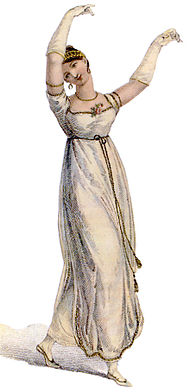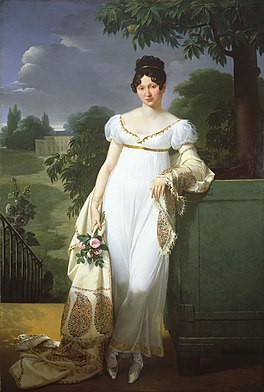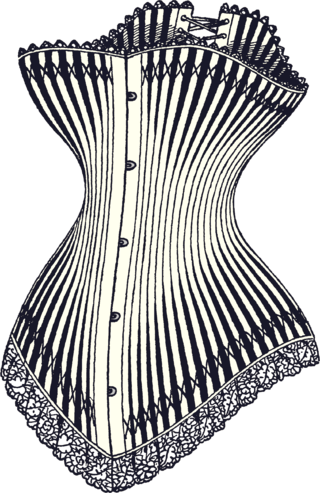
A corset is a support garment commonly worn to hold and train the torso into a desired shape, traditionally a smaller waist or larger bottom, for aesthetic or medical purposes, or support the breasts. Both men and women are known to wear corsets, though this item was for many years an integral part of women's wardrobes.
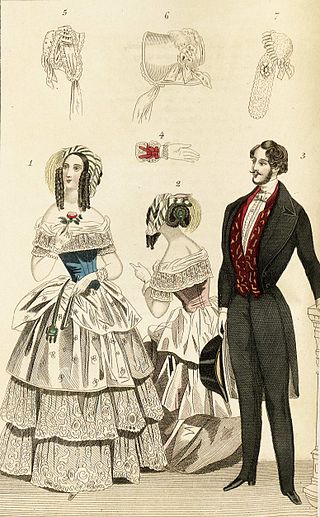
Victorian fashion consists of the various fashions and trends in British culture that emerged and developed in the United Kingdom and the British Empire throughout the Victorian era, roughly from the 1830s through the 1890s. The period saw many changes in fashion, including changes in styles, fashion technology and the methods of distribution. Various movement in architecture, literature, and the decorative and visual arts as well as a changing perception of gender roles also influenced fashion.

Tightlacing is the practice of wearing a tightly laced corset. It is done to achieve cosmetic modifications to the figure and posture or to experience the sensation of bodily restriction.

A chemise or shift is a classic smock type of women's undergarment or dress. Historically, a chemise was a simple garment worn next to the skin to protect clothing from sweat and body oils, the precursor to the modern shirts commonly worn in Western nations.

A tunic is a garment for the body, usually simple in style, reaching from the shoulders to a length somewhere between the hips and the knees. The name derives from the Latin tunica, the basic garment worn by both men and women in Ancient Rome, which in turn was based on earlier Greek garments that covered wearers' waists.

1830s fashion in Western and Western-influenced fashion is characterized by an emphasis on breadth, initially at the shoulder and later in the hips, in contrast to the narrower silhouettes that had predominated between 1800 and 1820.
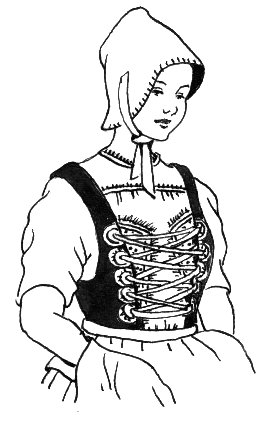
A bodice is an article of clothing traditionally for women and girls, covering the torso from the neck to the waist. The term typically refers to a specific type of upper garment common in Europe during the 16th to the 18th century, or to the upper portion of a modern dress to distinguish it from the skirt and sleeves. The name bodice is etymologically an odd plural spelling of "body" and comes from an older garment called a pair of bodies.
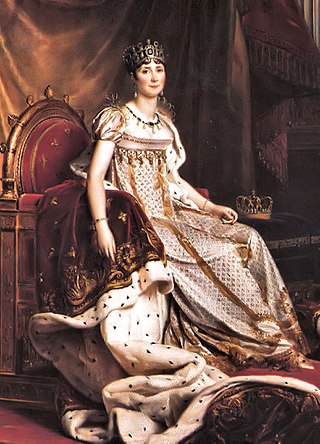
The waistline is the line of demarcation between the upper and lower portions of a garment, which notionally corresponds to the natural waist but may vary with fashion from just below the bust to below the hips. The waistline of a garment is often used to accentuate different features. The waistline is also important as a boundary at which shaping darts can be ended.

1840s fashion in European and European-influenced clothing is characterized by a narrow, natural shoulder line following the exaggerated puffed sleeves of the later 1820s and 1830s. The narrower shoulder was accompanied by a lower waistline for both men and women.
A dolman is either a military shirt, or a jacket decorated with braiding, first worn by Hungarian hussars. The word is of Turkish origin, and after being adopted into Hungarian, has propagated to other languages. The garment was worn by peasants from the 16th century onward and eventually spread throughout the country, mainly within wealthy peasant circles. It reached people living in the poorest conditions only at the end of the 19th century.
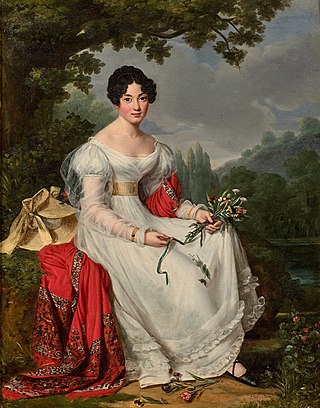
During the 1820s in European and European-influenced countries, fashionable women's clothing styles transitioned away from the classically influenced "Empire"/"Regency" styles of c. 1795–1820 and re-adopted elements that had been characteristic of most of the 18th century, such as full skirts and clearly visible corseting of the natural waist.

An hourglass corset is a garment that produces a silhouette resembling an hourglass shape characterized by wide hips, narrow waist, and wide bust.

Fashion in the period 1795–1820 in European and European-influenced countries saw the final triumph of undress or informal styles over the brocades, lace, periwigs and powder of the earlier 18th century. In the aftermath of the French Revolution, no one wanted to appear to be a member of the French aristocracy, and people began using clothing more as a form of individual expression of the true self than as a pure indication of social status. As a result, the shifts that occurred in fashion at the turn of the 19th century granted the opportunity to present new public identities that also provided insights into their private selves. Katherine Aaslestad indicates how "fashion, embodying new social values, emerged as a key site of confrontation between tradition and change."

Fashion in the period 1500–1550 in Europe is marked by very thick, big and voluminous clothing worn in an abundance of layers. Contrasting fabrics, slashes, embroidery, applied trims, and other forms of surface ornamentation became prominent. The tall, narrow lines of the late Medieval period were replaced with a wide silhouette, conical for women with breadth at the hips and broadly square for men with width at the shoulders. Sleeves were a center of attention, and were puffed, slashed, cuffed, and turned back to reveal contrasting linings.

Fashion in the period 1900–1909 in the Western world continued the severe, long and elegant lines of the late 1890s. Tall, stiff collars characterize the period, as do women's broad hats and full "Gibson Girl" hairstyles. A new, columnar silhouette introduced by the couturiers of Paris late in the decade signaled the approaching abandonment of the corset as an indispensable garment.

The preservation of fabric fibers and leathers allows for insights into the attire of ancient societies. The clothing used in the ancient world reflects the technologies that these peoples mastered. In many cultures, clothing indicated the social status of various members of society.

Fashion from 1910 to 1919 in the Western world was characterized by a rich and exotic opulence in the first half of the decade in contrast with the somber practicality of garments worn during the Great War. Men's trousers were worn cuffed to ankle-length and creased. Skirts rose from floor length to well above the ankle, women began to bob their hair, and the stage was set for the radical new fashions associated with the Jazz Age of the 1920s.

A dress is a garment traditionally worn by women or girls consisting of a skirt with an attached bodice. It consists of a top piece that covers the torso and hangs down over the legs. A dress can be any one-piece garment containing a skirt of any length, and can be formal or casual.

Twelfth century European fashion was simple in cut and differed only in details from the clothing of the preceding centuries, starting to become tighter and more similar for men and women as the century went on, which would continue in the 13th century. Men wore knee-length tunics for most activities, and men of the upper classes wore long tunics, with hose and mantle or cloaks. Women wore long tunics or gowns. A close fit to the body, full skirts, and long flaring sleeves were characteristic of upper-class fashion for both men and women.

Fashion in the twenty years between 1775 and 1795 in Western culture became simpler and less elaborate. These changes were a result of emerging modern ideals of selfhood, the declining fashionability of highly elaborate Rococo styles, and the widespread embrace of the rationalistic or "classical" ideals of Enlightenment philosophes.

